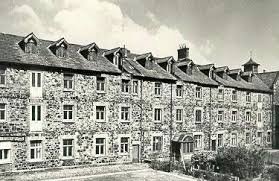The Belfast Workhouse - Origins
Belfast was one of 130 Unions set up under the 1838 Irish Poor Law. At the centre of each Union was a workhouse, designed to be the only place where the poor could receive official relief. This was a national system, funded by local poor rates, and managed by local Boards of Guardians. The majority of these Guardians would be elected by the ratepayers. Ultimate authority came from the central Poor Law Commissioners which were based in London until 1847 - men who had no experience of Irish poverty and the problems Irish workhouses were facing.
The first elections to the Belfast Board of Guardians took place in 1839 - there were no contests. The Board had 22 elected Guardians and 7 ex-officio Guardians, who were notable men from the local community and were placed onto the Board due to their standing.
The first Board started meeting and organising the collection of the poor rates and planning the building of the Belfast workhouse.
Each workhouse of the original 130 were built according to the same plans, designed by English architect George Wilkinson. Wilkinson used an “architecture of deterrence”, meaning that the separation of each group of paupers was designed into the building and its yards. The house was divided into male and female sides, further divided by age and ability so whole families would enter the workhouse and then be separated into their different groups. Paupers ate, slept and worked with only those in their group or class.
Architectural design of George Wilkinson
The size of each workhouse was determined by the population of the Union. As Ulster was the most densely populated, there were more workhouses in Ulster compared to the other provinces with 43 in total.
There were three models: small houses, capable of holding 200 - 300 paupers; medium houses for 400 - 600; and large houses for 1,000. All were designed to be able to hold a further 100 - 200 people.
In Belfast, the preparation and building work was completed relatively quickly compared to other areas in Ireland and the workhouse was officially opened to paupers on 11 May 1841. It was a large model with accommodation for 1,000 paupers. In its first year, it was only about half full but this was a relatively stable period in the town and soon, challenges would put this new workhouse and its Guardians to the test.
The Belfast Union workhouse

